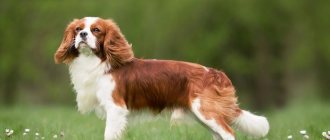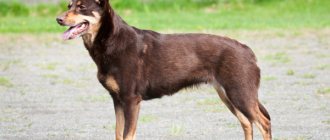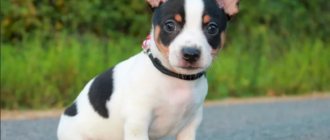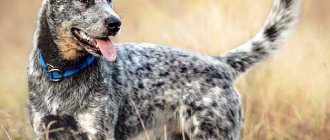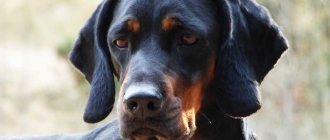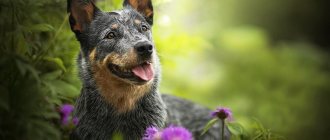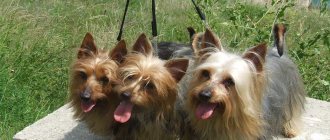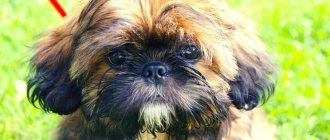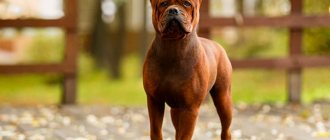Maintenance and care
Australian Kelpies are bred to work in fairly harsh conditions. This explains the relative ease of care.
Aussie wool is designed to protect against adverse weather conditions. It needs to be combed during shedding, but sometimes you can comb it to add shine. There is no need to cut your dog's hair.
Kelpies should only be bathed when they become dirty. Frequent bathing is contraindicated, as this may disrupt natural defense mechanisms. After a walk, just wipe your paws.
For the Australian, regular cleaning of the ears and eyes, as well as shortening of the nails, is mandatory.
Kelpies are also quite unpretentious in their diet. Puppies need 3-4 balanced meals a day high in calcium and phosphorus. For adult dogs, ready-made food for active animals is suitable; it is also possible to combine dry and natural food. Kelpies love food that is rich in protein and contains minimal grains.
This breed is completely unsuitable for living in a city apartment. Kelpies need constant walking and physical activity. In addition, you can assign a certain range of responsibilities to an Australian and he will cope with it perfectly. This will allow him to feel like a full-fledged working dog.
The average lifespan of an Australian Kelpie is 15 years, and with good care it can last up to 18. Even at the age of 10 years and older, they are able to remain productive and active.
Australian Kelpie Health
All Kelpies have excellent health. Their lifespan is 12–14 years, and many individuals retain activity and working abilities even after 10 years. But sometimes there are still diseases that appeared as a side effect of selection:
- Dysplasia of the hip (less commonly, elbow) joints. With pathology, the articular head is incorrectly located in the articular bed and over time wears out the cartilaginous layer. The disease leads to lameness and disability, but at the first signs (disturbance in gait), the dog can be helped with drug therapy or surgery.
- Cryptorchidism is the failure of one or both testicles to descend into the scrotum (in males). For working dogs, this does not threaten anything; in the standard, this pathology is considered a disqualifying sign.
- Cortical abiotrophy of the cerebellum (death of cells responsible for orientation in space). The first signs of pathology appear between the ages of 1 and 6 months: trembling of the limbs, uncoordinated movements, lack of balance when walking. This disease is incurable, but with care from the owner the animal can live a long life.
Buying an Australian Heeler puppy
Nowadays, an increasing number of proven nurseries are appearing in Russia, where you can get acquainted with the pedigree and see the parents of puppies. As discussed in the health chapter, due to some hereditary predispositions, it is advisable to study your pet's family tree in as much detail as possible before purchasing.
Meeting the puppy’s family is an integral and important ritual before purchasing
As in the case of other purebred dogs, it is not recommended to take a puppy from unknown sellers who do not provide comprehensive information about the pedigree.
The most popular nurseries are “DingoStar” and “DingoBells”, information about which can be found on their own websites. Of course, the best option would be a personal visit to Australia and an agreement with the breeder to transport the pet, but such time and financial costs are not available to everyone.
Floor
If you are thinking about which gender to prefer, then it is impossible to give an unambiguous recommendation. Both male and female are functionally no different from each other - regardless of gender, these dogs are excellent shepherds.
Both boys and girls show equal diligence and dedication in life and work
Keeping a female dog is complicated by two features: 1) girls shed twice as often as boys; 2) estrus occurs simultaneously with molting. If the high probability of a stained sofa or carpet does not bother you, then you don’t have to think about the floor at all. There are no other differences between the male and the female.
Price
On average, the price of an Australian heeler from official breeders reaches 40-50 thousand rubles. Of course, there are cheaper, but less safe options, in which the price tag drops to 10 thousand. What to prefer - confidence in the health and well-being of the pet or cheapness - is a question that every owner answers himself.
Pet health
Australian Kelpies enjoy good health, however, there are several ailments to which they are susceptible:
- vision problems in adulthood;
- cryptorchidism;
- joint diseases due to increased activity of dogs.
The most common cause of death for kelpies is accidents with cars!
Dogs do not see them as a danger, so when walking you need to carefully ensure that your pet does not jump out onto the road!
To prevent the occurrence of diseases, owners need to regularly visit a veterinarian to examine their pet. You also need to get all your vaccinations on time. The first is given to a puppy at the age of 1.5-2 months. Further, their schedule depends on the chosen drugs, and the exact date of the visit is set by the attending physician.
Mating
Mating must be taken very seriously in order to get healthy offspring:
- Before the procedure, be examined by a veterinarian and take genetic tests. Unfortunately, if the dog is a carrier and especially a carrier of a disease that will affect the offspring, mating is prohibited. Various crossing options are considered when there is a high probability of the birth of healthy puppies. The breeders are responsible in each case.
- Heelers that have reached 1.5 years of age are considered sexually mature. Bitches go into heat in the autumn and spring. It is customary for owners to breed a pair on the 2nd or 3rd heat and 8–10 days after the start.
- Mating takes place traditionally in the territory of the male. If the male does not recognize the female and shows aggression, the procedure is repeated every other day. The best time of day for mating is morning.
- After proper mating and three months of gestation, puppies appear. The quantitative component of the litter is 1 – 7 pieces.
Health, illness
Australian Kelpies very rarely get sick. They have excellent health. Thanks to this, they do not require increased attention and special care. Although in some cases there may be a tendency to progressive retinal atrophy. The disease is genetic, so if it overtakes your pet, unfortunately, there is nothing you can do. In order to find out whether your pet is a carrier of this disease, you need to do a genetic test. If the result is disappointing, you will have to protect the animal from mating or sterilize it. If you lose your vision, don’t be upset, nothing can be done; the sense of smell and hearing will sharpen, and of course the owner’s love!
History and breed standard
The history of the origin of the Australian Cattle Dog breed, unlike many other, more ancient dog breeds, is not shrouded in speculation and mystery. It all started in Australia, when settlers and convicts from the British Empire began to develop an uninhabited and sparsely populated area on the Australian continent - the state of New South Wales.
By the beginning of the 19th century, it was turned into a cattle-breeding state and English farmers began to import herding dogs to the continent - “black bobtails”, or Smithfields, which had proven themselves well in England. But they turned out to be unsuitable for the Australian climate, too large and heavy, constantly suffering from the heat.
Then, around 1830, they were crossed with the Australian dingo, but the resulting dogs turned out to be too biting, although they were more resilient and silent. Then there were attempts to cross a long-haired collie and a bull terrier, but this also failed. Selection work continued, the descendants of the first experiments became better in terms of working properties, but did not yet satisfy all the requests of farmers.
Around 1840, landowner Thomas Holya brought short-haired Scottish blue collies from England. He crossed them with dingoes so that the new dogs could better withstand the Australian heat; the resulting dogs were distinguished by good working qualities. In 1850, J. Elliott from Queensland did the same. The new dogs coped well with guarding livestock. A characteristic feature of dogs from Queensland was the habit of biting cows on the heels, for which they were nicknamed blue or Queensland heelers.
A little later, farmers the Baghast brothers from the outskirts of Sydney infused the healers with Dalmatian blood to enhance the endurance of the breed. As a result, the Blue Heeler inherited a love of horses, a speckled roan coat pattern, and tremendous stamina.
To consolidate and enhance all working properties, the blood of the Australian Kelpie was added already in the 20th. The new breed took on its modern appearance and became commonly known as the Australian Cattle Dog or Australian Heeler. Very popular and common in Australia, but rarely found outside of it.
In 1989, the first international breed standard was developed and approved. According to the ICF classification, the Australian Cattle Dog or Australian Heeler belongs to group 1: Herding and cattle dogs, except for Swiss cattle dogs, section 2: Herding dogs, FCI standard No. 287. In the latest edition dated September 1, 1997, performance tests were removed from the standard, and in vain.
Breeding Features
The Australian Kelpie is an excellent breed choice for people leading an active lifestyle.
If you want to adopt a pet of this breed, you need to seek qualified help from the nursery where the puppy was purchased. The rarity of the breed for the territory of Russia practically does not give the dog a chance to independently find a partner and comply with all the rules of mating and breeding.
These dogs are not suitable for homebodies. The minimal required care and increased trainability make the Kelpie even more attractive to novice dog breeders.
Appearance
Kelpie agility
An agile, active dog, combines a strong, muscular build and very flexible limbs, tireless in work.
The head is proportional to the size of the body. The overall shape and contours create a somewhat foxy expression, which is softened by the almond-shaped eyes.
The skull is slightly rounded, wide between the ears. The transition from forehead to muzzle is pronounced.
Kelpie walks on the backs of sheep
The muzzle is clearly “chiseled”, slightly shorter than the skull. Lips are tight and dry, not saggy. The color of the nose is in harmony with the color of the coat.
The eyes are medium in size, with clearly defined corners, expressing intelligence and diligence. Color - brown, in harmony with the color of the coat. Blue dogs may have lighter colored eyes.
The ears are erect, pointed, and of medium size; the skin is thin, denser and stronger at the base, the ears are widely spaced and tilted forward, with slightly curved outer edges. The inside of the ear is covered with rather thick hair.
The teeth are strong, evenly set, with a scissor bite, that is, the upper incisors overlap the lower ones.
The cheekbones are not rough, not protruding, and rounded towards the muzzle.
The neck is of moderate length, strong, slightly arched, with a slight scruff, gradually turning into the shoulders, without dewlap, with a “collar”.
The length of the dog's body from the anterior protrusion of the sternum to the ischial tuberosity in a straight line exceeds the height at the withers in a ratio of 10 to 9. The top line is clear and level; the lower back is strong, muscular; the croup is quite long and sloping; the chest is developed more in depth than in width; The ribs are noticeably rounded, the side is quite deep.
Best articles: How to take a cat's temperature?
The forelimbs are muscular, with strong but dry bones. When viewed from the front, they are straight and parallel. The shoulder blades are clearly defined, muscular, with a noticeable slope. The upper edges of the shoulder blades meet closely at the withers. The angle of the humeroscapular joint is straight. The elbows turn neither in nor out; the pasterns, when viewed from the side, have a slight slope, which provides flexibility of movement and the ability to quickly turn.
The hind legs are wide, strong, and the knee angle is well defined. Seen from behind, straight and parallel, not too close and not too far apart. The hock joint is low. The feet are round, strong, with deep pads, arched, balled toes and strong, short nails.
Kelpie returns sheep to the pen at a herding dog competition
The tail, at rest, hangs down slightly, bending slightly. When moving or in an excited state, it can rise, but it should not go beyond the vertical line drawn from its base. It ends with a “tassel”. Set on in accordance with the slope of the croup, reaching to the hocks.
Movements should be free and tireless; The dog must have good turning mobility at high speed. When trotting, if the speed of movement increases, the paws move closer to each other; at rest, in a stance - the paws are located along the perimeter of the rectangle. Swinging or “crossing” your legs when moving is undesirable.
The coat is double, with a short, thick undercoat. The guard hair is dense, straight, hard, tight-fitting, waterproof. Under the body and on the back of the thighs, the hair is longer and forms short fringes. The hair is short on the head (including the inside of the ear) and towards the front of the legs and paws. Along the neck the hair is longer and forms a collar. A coat that is too long or too short is considered a fault. The average length of the body coat is 2-3 cm.
Color: black, black and tan, red, red and tan, fawn, chocolate, smoky blue.
The height at the withers of males is 46-51 cm, females - 43-48 cm.
Breeding
A bitch can only be bred after reaching the age of two. Early pregnancy will lead to health problems and the litter will be weak. Kennels carry out matings only through the breed club - people who breed kelpies privately also need to do the same.
A male dog should also not be untied before two years of age - this will negatively affect his behavior. Before bringing dogs together, both dogs should be checked for diseases by a veterinarian.
If the mating is carried out through the club, the puppies will receive metrics and then pedigrees. Such pets can be shown at exhibitions and are allowed for breeding.
Types of herding breeds
Each region uses its own national herding dogs to guard the herd. There are many varieties, but the purpose is the same - to protect the herd from attacks by predators and to help the shepherd drive the cattle to the field.
Initially, this craft used bloodthirsty, fearless dogs of enormous size, ready to fight wild predators and even bears. But the years passed, the world improved, wolves and foxes were shot, which made grazing easier and safer. Shepherd dogs have become smaller in size, and their character has become more loyal to others. Let's look at the most common types of herding dogs.
Scottish collies
The breed originates from Scotland, where it is valued for its loyalty and love for its family. An excellent loyal friend and assistant, she has a high mind and intelligence, she is characterized by responsiveness and compassion, affection, and courage. Despite the herding type, the collie is a welcome friend in every family. She is easy to train, disciplined and smart, loves children and is ready to stand up for her family no matter what.
The Scottish shepherd dog became very popular in the 50s after the release of the film "Lassie", which showed a real collie, brave, smart, loyal and loving.
Collie height is 65 cm, and weight is up to 35 kg. The breed is characterized by long, thick red-and-white fur. They tend to lead an active lifestyle: they love to play, run, bark and chase moving cars. They are participants in many contests and competitions, but at the peak of their fame, unscrupulous breeders were engaged in breeding puppies, so their purebredness weakened.
When buying a puppy, you need to pay great attention to its gender and get acquainted with the documents of the parents. It is better to buy from a breeder with a good reputation, who values his name and sells quality puppies
The cost ranges from 20 to 50 thousand rubles.
Border Collie
An incomparable shepherd dog, one might say, one of the best. The Border quickly learns commands and is very smart, which sets it apart from other breeds. The origin comes from England, or more precisely, from the border area between England and Scotland. Historical data indicates the emergence of the Border family as early as 1570.
A graceful, slender, but at the same time strong and strong dog. The coat is short and medium length, there is an undercoat, thanks to which it does not freeze in cold weather. Outwardly not as beautiful as a collie, but quite smart. By nature, the dogs are very smart, balanced, easy to learn and trainable.
The English Cattle Dog is an excellent herder. She can independently graze the herd, knowing each sheep by smell, controls the process of pasture and the location of the herd in the field, preventing predators and strangers. You will have to pay a lot for a border puppy: their cost is 25,000-50,000 rubles.
Australian Cattle Dog - Heeler
The heeler was bred in Australia for driving sheep and cows over long distances. To breed extremely hardy “shepherds,” short-haired collies and wild dingoes were used. As a result of selection, a new type of pet was developed, capable of very long walks, hardy, smart, flexible, strong, brave, but a little stubborn.
The dogs are easy to train, smart, strong, with a muscular build, very active, but despite this, affectionate, loyal and loving, ready to defend the family in any situation. Their population around the world is growing every day.
Bernese Mountain Dog or Bernese Shepherd
Another type of four-legged shepherd is the Swiss Shepherd. The roots of the breed grow from the city of Bern, hence the name - Bernese Mountain Dog. Pets make you fall in love at first sight with their beautiful appearance, aristocratic behavior and manners; four-legged animals often appear in films and are wildly popular as pets.
By nature, representatives of the family are calm, good-natured, affectionate, balanced, do not show aggression towards other pets and strangers, but are ready to become excellent guards and protectors of the family. They tend to be peaceful, so in suspicious situations they bark and growl loudly, but rarely attack. Amenable to training and strict discipline.
Breed care
The Australian Shepherd is not long-haired, but it still needs regular brushing. This should be done with a wide-toothed metal brush or slicker brush. In case of irregular grooming, the fur becomes matted, which will be difficult to remove.
The Kelpie's homeland is Australia. Therefore, the dog is unpretentious. It can be washed only in case of serious contamination. In warm weather, she sleeps quietly outside without a booth.
Important! It is necessary to control the regrowth of claws. If they do not wear down naturally, the kelpie may accidentally tear them off. The claws are trimmed with special nippers.
History of the breed
Kelpies were bred by Australian shepherds by mixing the blood of the wild dog dingo and the smartest of all dog breeds - the border collie. There is also an opinion that they descended from dogs that arrived in Australia along with the first settlers. The first mention of the breed dates back to the end of the 19th century.
The fact that the breed originated from dingoes is supported by the fact that some habits of wild dogs can be traced. When the kelpie works in the field and herds cattle, she lowers her head so low as if she is about to attack a sheep. This behavior is more reminiscent of hunting than herding, but it is a distinctive feature.
Professional breeding of these herding dogs in Australia began only in 1956; now more than 100 thousand Kelpie dogs live on the southern continent.
Dogs came to Russia in the 80s of the 20th century. In 1987, the USSR purchased 30 kelpie puppies from Australia for use on sheep pastures on state farms in the Stavropol Territory and other regions of the country.
Nowadays, the Kelpie is the most popular and beloved herding dog in Australia and other countries of the world, although these dogs are little known in Europe.
Disadvantages and grounds for disqualification
Australian Silky Terrier (Seal): description of the breed
Any deviation from the standard or defects in the exterior are considered unacceptable. Kelpie is a dog breed that requires high working qualities.
Important! The first examination of puppies is carried out in the first months of life and metrics are issued based on it.
Serious deviations are considered to be white spots on the coat, short stature or too tall, incorrect bite. For full development, the puppy is provided with proper nutrition. If there is a lack of vitamins, he will have problems with growth.
Character and training
Against the backdrop of pronounced grace, representatives of the breed are distinguished by endurance and well-developed hunting skills. The Arabian Greyhound has an aristocratic and very independent character. Representatives of the breed are very active, which must be taken into account before purchasing a puppy.
The Arabian Greyhound is very loyal to its owner. The puppy chooses the leader of the family literally a few hours after arriving at its new home. Despite its affection and unbearable separation, the Arabian Greyhound does its best to hide its sensitivity. The truth is revealed when you try to get another pet or when there is a lack of attention. The Arabian Greyhound becomes very jealous and can intentionally cause damage, for example, chewing personal belongings or making a puddle on the owner's bed.
Slugs are very suspicious and wary by nature. The breed does not show signs of aggression, but they can attack quickly and quickly. Like other sighthounds, the Arabian Hound delivers several deep bites with lightning speed, moving from the limbs to the head of the victim. In everyday life, Slugs are gentle and affectionate, provided that they are not in danger. The breed is not recommended for families with small children, since the toddler may not intentionally harm the dog, and the consequences of such actions are unpredictable.
Best articles: TOP 10 facts about the saber-toothed tiger with picturesThe Arabian Greyhound has a fine mental structure and is prone to empathy. A dog can become irritable if there is a conflict situation in the house. In the first 2–3 years of life, the owner must make every effort to raise an obedient and mentally healthy dog. To achieve this goal, the Arabian Greyhound must be constantly socialized.
Established owners note that Slugs are very independent and their decisions often run counter to those of their owners. The Arabian Greyhound usually obeys only one family member. By the way, representatives of the breeds are prone to escape if they sense potential prey. Even if the dog is well trained, it should not be let off the leash in unfamiliar areas or near the roadway.
Character traits
Individuals of this breed are flexible and active dogs that perfectly combine significant muscle strength with significant paw flexibility, which indicates the ability to constantly work. In this case, there is no hint of lightness of physique.
Representatives of this breed are characterized by high intelligence and inexhaustible energy. Loyalty to people and dedication to one's work are expressed. There is no defect in physique or character that can impair the properties of working dogs.
Australian shepherd: the history of the appearance of the kelpie breed
The first mentions of dogs similar to Australian kelpies do not go back centuries; they date back to the nineteenth century. However, to this day no single version has been formed about the origin of these animals. Dog handlers and breeders cannot answer unequivocally: who exactly was the ancestor of these shepherd dogs. There is evidence that kelpies appeared in Britain, their “parents” were collies. There is no need to confuse the collies of those times with those of today.
The British used the word “collie” to describe short-haired, pitch-black dogs. It is believed that this name comes from English words denoting both coal (tracing paper - coaler) and the sea ships that transported this coal (collers). The first kelpies came to Australia with settlers, and there the blood of local dogs, wild and domesticated, joined the emerging breed.
It is believed that dingoes were among the ancestors of Australian kelpies.
In the mid-nineteenth century, Australians were prohibited from domesticating wild dingoes, so owners bred these animals secretly. The ban on dingoes living in farmers' houses was due to the fact that these predators killed livestock. At the same time, wild dogs were distinguished by unique endurance, speed and strength, so many still wanted to have such a guard and hunter at their disposal. Wild dingoes were crossed with domestic dogs, including collies imported from England, but such matings were not publicized.
Wild dog dingo
It was these mixed breeds with dingoes that became the ancestors of the kelpies. The first Australian Kelpie dog that history remembers was a black and tan female, which the owner purchased from a traveler from Scotland at a railway station. The seller informed the buyer that the animal's name was Kelpie, as a tribute to the spirit about which the Scots made legends.
Kelpie is a relatively young breed, having been formed for about 15 years
The dog so impressed the Australian with its intelligence that he decided to get offspring from it. The first breeder bred Kelpie with other local dogs, trying to maximally improve its working qualities associated with herding sheep. At the same time, the farmer cared little about appearance, so the puppies that Kelpie brought were completely different in color and size, depending on the male with whom he mated his dog.
The puppies were readily taken, and local cattle breeders soon realized that Kelpie blood was very valuable to them. In 1990, they decided to bring the breed to a single exterior standard in order to register a new breed and take it to participate in exhibitions. Four years later, the first Australian Kelpie breed standard was published, which was approved by many professional breeders.
Australian Kelpie puppies
Unlike breeders, ordinary farmers did not approve of the emergence of an external standard. They believed that the emphasis on breeding exterior dogs could harm their working qualities, so they continued to breed not the most beautiful animals, but those who did their job better than others. For this reason, in Australia there is still a division in the breed: show kelpies and working kelpies.
Working dogs continue to amaze and confuse with their external diversity; representatives of the “show” class look strictly as prescribed by the standard. Therefore, strictly speaking, there are not many animals that have the right to be called “Australian Kelpies”. In fact, more than one hundred thousand working kelpies are currently helping farmers manage sheep flocks in Australia.
Kelpies help farmers with their sheep flocks
Character
Thousands of Australian and American cattlemen will say that these dogs are a vital part of their work. Although show kelpies are slightly less energetic than their working brothers, this difference is only noticeable to the farmer. They are loyal and form relationships with their owners that last a lifetime. Some of them love only the owner, while others love all family members.
Although they prefer the company of their owner, they can work for hours without his help or orders, alone or in a pack with other dogs. Their attitude towards strangers depends on socialization. When correct, they are friendly and polite; when incorrect, they are wary or slightly aggressive. They are always alert and can be good guard dogs, but they are not ideal as they are small and not very aggressive.
Australian Kelpies are tireless working dogs. They were bred as herding dogs and have all the characteristics necessary for such a breed.
After a hard day at work, Kelpies come home to relax and therefore get along well with children. But for little ones they are not ideal companions, as they play too harshly and can pinch the child. They are used to pinching and biting sheep to control them. And with little ones they can behave like sheep in order to control them. Although this is instinctive behavior, not aggression, and the dog can be weaned from it.
In relation to other animals, they behave differently. Because they often have to work in a pack, they can form strong bonds with other dogs. They have low aggression towards strangers. But, most males try to take a dominant position, although they are not as dominant as other breeds.
Australian Kelpies work with livestock, and can live with almost all animals in the world. However, it is in their blood to drive any animal, be it a bull or a cat, which can lead to injury in small pets. Not very often, but in untrained kelpies this instinct can develop into a hunting instinct.
This is an intelligent and easy to train breed. There is nothing that they cannot learn, and very quickly. Although they are used as herding dogs, they also serve as rescue dogs and working dogs. However, for an inexperienced owner, the training will be a real test. Kelpies are independent and like to do what they want. They don't need to give commands, they know everything that way. Without being dominant, they quickly understand who needs to be listened to and who can be forgotten. If you fall into the second category, then you have problems, as they love to play mischief. If you don't put them in place, they bloom.
Like the Australian Cattle Dog, Australian Kelpies require a huge amount of activity and work. They are born to work for a long time under the scorching sun, until the moment they literally collapse from fatigue. They have become an important part of the Australian livestock industry and not only do they have to work, they can't sit idle. Not only a daily walk, but even a jog is not enough for them; they need several hours of heavy exercise every day; free space for running and keeping a kelpie in an apartment will be akin to a disaster. For an ordinary city dweller, the requirements are impossible to meet, since the dog needs a lot of exercise. And if you are not able to give it, then it is better to refuse to buy the rivets.
Even the most educated and self-possessed of them become terrible if they do not receive their due. They can destroy everything in the room, if not in the apartment, howl, bark, and chew. And then they develop manic states and depression. In order for the Kelpie to be happy, the owner must load it not only physically, but intellectually. And it doesn’t matter whether it’s sheep management or an agility course. Unlike other breeds, Kelpies' energy levels do not decrease with age. Most dogs are just as active at 10-12 years old as they were at 6-7.
Naturally, they are best suited for farmers, especially those involved in livestock farming. A lot of work, a big yard and freedom, this is the recipe for their happiness.
Nutrition
The nutrition of puppies and adults should vary depending on their physiological state, physical activity, type of activity, time of year, and age. Therefore, let us consider in more detail the features of feeding animals of different ages.
Puppy
Dog handlers advise sticking to feeding your puppy four times a day. But you shouldn't feed your pet. If he doesn't finish the whole portion, don't force him. Also, do not give him sweet or salty foods. Prepared food must be cooled so that it is not hot; But food that you just took out of the refrigerator should not be given to the animal right away either.
If you got a puppy, it will be useful for you to read about how to feed a puppy, at what age to give a puppy the first vaccination, what are the basic rules for training a puppy at home, how to teach him the commands “Come to me” and “Give me a paw”, and also, what are they for and how to motivate your dog with treats.
Important! Under no circumstances feed puppies sweet, spicy, or salty foods. Avoid food with spices
Do not feed tubular bones, pork, whole milk, river fish, legumes, cabbage, potatoes, or sausages.
Adult
Food for an adult dog per day is calculated as 5% of the total weight of the animal. Basically, chicken, beef, porridge, cottage cheese, eggs should predominate. Feed your kelpies beets, carrots, cucumbers, zucchini, pumpkin, and greens.
For better digestion of food, give stewed vegetables. The dog is not fed broths and soups, because then its belly sags.
What to feed?
The peculiarity of Kelpie nutrition is that the diet will have to be thought out for each age period. It is not recommended to feed your dog the same food for life.
For a healthy pet, consider the following factors:
- Physiological state. This includes the phases of growth and development, the period of pregnancy and subsequent feeding of babies, the aging of the dog;
- Using a pet. It is worth considering the ratio of the dog’s workload and rest;
- Conditions of detention. This includes the pet’s immediate residence;
- Season. In certain periods, the dog requires increased portions of vitamins and minerals.
Puppies are small, energetic animals eager to explore the world and play tirelessly. For full development, it is necessary to compose a diet taking into account the content of necessary substances.
Of course, first of all, the dog needs calcium and phosphorus, otherwise the bones will become brittle and painful. It is convenient to build nutrition based on modern food; the mixtures are completely balanced taking into account the age, type of dog and lifestyle.
Features of the breed and character of the Kelpie
The Kelpie has a fairly strong bone structure, but is not a large dog. This feature is due to the fact that this breed was used for grazing cattle.
Kelpie has excellent balance, which allows him to walk on the backs of sheep
Having a large size, the dog will not be able to maneuver in order to protect itself from ungulates. And the Kelpie breed copes with this very well, because it is not for nothing that they have gained popularity in agility.
The Australian Kelpie will be remembered by anyone for its appearance - high-set, erect, fox-like ears, lively, expressive eyes and a sharp muzzle. What adds to the charm of this breed is its slightly elongated body, which looks a little awkward, but has excellent practical use in grazing livestock. Kelpies are often pictured on the backs of sheep and it's easy to see why.
The Kelpie standard is detailed in the FCI document. Before purchasing a kelpie puppy for exhibition, you must check the puppy's parents with what is written in this document. But if the dog is purchased as a companion or herding dog, then there may be some discrepancies.
For example, if a kelpie's color has a large white spot on its chest or white “socks,” then it is not suitable for exhibition, but this reduces the price of the puppy. The lower limit of height at the withers for females is 43 cm, for males – 46 cm. The upper limit should not exceed 48-51 cm. The weight of an adult dog varies from 11 to 20 kg.
But despite the size, which would seem well suited for keeping in an apartment, this dog needs a spacious abode. The echoes of their shepherd ancestors in their blood do not allow them to lie quietly on the sofa all day long, so without proper physical activity, the kelpies will begin to destroy the apartment.
This dog should always be busy and then it will be truly happy and devoted to its owner. If it is not possible to provide the kelpie with her usual work in the pasture, then active cycling, hiking in the forest, agility, freestyle or Frisbee dog would be an excellent substitute.
Best articles: Instructions for using the sedative drug Stop-stress
And don’t forget about one strange habit of the Australian Kelpie - biting your legs! The original purpose of this skill is to return stray or lagging cattle, but in ordinary life this can be a manifestation of destructive behavior due to the lack of proper stress. But despite this strange feature, the Kelpie is a breed suitable for families with children. Playing with her will be one of the main entertainments for such families.
Thanks to their intelligence, these dogs learn very quickly and have no problems remembering new commands. But to achieve complete obedience from a dog, you will have to try. Unfortunately, this breed is quite stubborn, but if the owner can control his temper and achieve trust, then this will be his best friend and companion!
Kelpie is a very energetic dog and needs space
Dog training
Despite the main purpose of the dogs (“profile” herding dogs), Kelpies are easily trained in various disciplines and areas. Competent dog handlers recommend choosing the direction of training depending on the character of the growing puppy, constantly watching the baby. The dog must like what they do with it, then the animal will achieve success.
In team games with other dogs, especially small ones, kelpies show the makings of a leader, which can be explained by their purpose as a shepherd. Already as a puppy, they begin to show character and largely inherit the behavior or habits of their older relatives, mother or brothers. From the first days of walking, after vaccinations, it is advised to take the baby in tandem with a trained dog and show training by example. Australian Shepherds trained Kelpies in a similar way.
As a reward for correctly executed commands, it is better to choose a voice and intonation; you should not accustom the dog to constant treats. Dog trainers recommend the contrast training method, combining negative and positive reinforcements. The operant method is recognized as effective, excluding physical contact with the animal, replacing touch with a conditioned signal. For example, buy a training whistle. It is permissible to combine the sound of a whistle and encouragement; at first, do so: after the conditioned signal and the execution of the command, the dog receives a treat or a pat on the withers. Gradually they refuse encouragement and leave the team on the whistle.
The breed is highly trainable, so training a Kelpie will not be difficult. He understands perfectly well what the owner requires, obeys unquestioningly and carefully assimilates new commands. Thanks to his qualities, he easily carries out commands at a distance. To make the process enjoyable for the owner and the dog, Kelpies are taught discipline from an early age. This is easy to do; you just need to keep your baby busy with certain activities. Innate intelligence and curiosity will help puppies fully immerse themselves in the proposed activity.
The dogs were bred to look after livestock; their curiosity and reactivity made it possible to control grazing animals. Dogs are not averse to running and playing with children. In relation to children, dogs are considered irreplaceable friends - they become companions, while at the same time controlling.
Kelpies begin to master herding skills from an early age - one and a half months, provided that an adult is nearby, then Kelpie puppies feel calm and learn skills developed at the highest level. A distinctive feature is the ability to deftly jump from the back of one sheep to another, which allows you to put the herd in order in a short period of time, rather than spending the whole day running around them. The pet will protect an animal that has strayed from the herd, returning it to its relatives. Kelpies have an incredible gaze that can hypnotize a flock; under this influence, the flock unquestioningly obeys the shepherd.
Rules for keeping pets
All pets of herding breeds are kept in enclosures or spacious pavilions; it is not advisable to keep them on a chain, and their large size will not allow them to live with you in an apartment. Dogs love long walks, fresh air, exercise, and are not averse to hunting and observing their surroundings. Thick and dense wool will not allow the pet to freeze in cold weather and cold; for insulation, it is enough to add hay to the kennel.
When raising a puppy, you should be strict and reward him with goodies for positive achievements in training. Try to walk the puppy in public places to accustom it to society; in adulthood, it is necessary to have a muzzle and a strong leash. Remember, full maturation and maturation lasts up to two years, during this period the pet may behave atypically, be patient and do not stop training.
Diet features
Like all pets, herding breeds require careful diet and balanced nutrition to maintain strength and health in such a large body. The main components of natural dog food are:
- Meat (beef, lamb, horse meat).
- Large bones (beef or lamb).
- Vegetables, fruits (both fresh and dried), herbs.
- Porridge.
- Raw eggs (no more than 4 eggs per week).
- Be sure to have fresh, clean water.
Briefly about care
Dogs are unpretentious and rarely susceptible to disease; it is only important to vaccinate puppies on time.
- It is possible to bathe the kelpie once every couple of months.
- Comb out every other day. In principle, dogs are slightly susceptible to shedding.
- In food, you should use the amount of protein that the dog will spend, otherwise the pet will lose its shape. More protein and calcium are included in puppy foods as the baby develops.
A dog needs nature and vast spaces; life in the city is not for it. Proper Kelpie care takes into account the dog's activity. You should not accustom your pet to a sedentary lifestyle - the pet is created for movement and work, it requires space to run. Keeping a pet in an apartment is contraindicated.
The dog does not need grooming. To maintain a healthy coat, you only need to comb it slowly and thoroughly so that the dog enjoys the process and the coat shines after the procedure. This action allows you to take care of your skin. Kelpies are prone to shedding. At such moments, a brush will not help; it is better to purchase a sheepskin scraper.
It is important to trim your dog's nails regularly to prevent them from breaking or peeling. The haircut is done carefully; damage to the capillaries will not bring anything good.
Description of the breed
As stated earlier, the Australian Kelpie is primarily a herding dog breed. The height at the withers of representatives of this breed varies from 46 to 51 centimeters; females are somewhat smaller, their height varies from 43 to 48 centimeters.
Breed standard
In Australia, this breed is very popular and still remains the most important assistant for farmers. The main distinguishing feature of these animals is their wide viewing angle, which in turn makes it possible to achieve the utmost emphasis when observing herds. The average life expectancy of representatives of this breed is about fourteen years, of course, if the animals are properly cared for and provided with a balanced diet.
Among other things, kelpies are also distinguished by the following features:
- the animal’s head is proportional to the body and is of medium size;
- the skull is distinguished by a rounded shape and a pronounced transition to the muzzle;
- a medium-sized nose with a color that depends entirely on the coat color of the dog;
- lips thin and compressed;
- the eyes are almond-shaped and quite expressive, while the eye color is brown, but can have completely different shades;
- ears are vertical, medium size, widely spaced;
- the teeth are strong and even, having a scissor bite;
- the length of the neck is average, has a slight bend and scruff, while there is no pendant at all;
- the body is quite strong and muscular, with a fairly deep chest;
- the lower back is strong;
- legs are straight and parallel to each other;
- the paws are round in shape with fairly large pads and powerful claws of short length;
- the tail is of medium length and slightly curved.
Advantages and disadvantages
Thanks to all their features, representatives of this species are considered simply magnificent shepherd dogs, which have high speed, endurance, and loyalty. Among other things, these dogs are extremely hardworking, intelligent, fast-learning and balanced animals.
Despite the huge number of advantages, these dogs also have certain disadvantages, most likely one of them is that they absolutely cannot live in apartment conditions, since they really love free space.
Purpose of the breed
In Australia, energetic and unique Sheepdogs are used most often for working purposes. As for foreign countries, they are more popular in sports there.
Unique shepherd dogs are most often used for working purposes.
This species is especially popular in our country, but here these dogs are most often used as guards of the territory for various purposes. Also, some people get these dogs solely for the soul.
Coat
A breed such as the Australian Kelpie is distinguished by fairly short and stiff hair, which, due to its density, does not allow the dog to get wet. At the same time, the coat has a fairly short but thick undercoat. The most common colors found in representatives of this breed are:
- black;
- black and tan;
- ginger;
- red with tan;
- chocolate;
- pale yellow;
- smoky with a blue tint.
Animal character
Another feature of kelpies is that representatives of kelpies can smile. These dogs are distinguished by their friendliness and at the same time excellent protective qualities. These dogs are very affectionate and never refuse to carry out various tasks of their owner.
Thanks to its characteristics and features, the Australian Kelpie can perfectly cope with numerous flocks of animals, herds of cattle, as well as numerous flocks. While working, representatives of this breed skillfully force all animals to obey them.
A special feature of the Kelpie is that representatives of this breed can smile.
The main advantages of these animals include the following features of their character:
- curiosity;
- endurance;
- mind;
- attentiveness;
- loyalty;
- independence.
Kelpie training
Experienced dog breeders have no problems training this breed.
After recognizing the owner as a leader, the dog tries in every possible way to please him.
During training, it is necessary to show firmness and perseverance, but do not forget to encourage the dog.
For beginners, it is better to seek the help of a professional who will tell you how to behave with a dog and how to teach it commands.
The dog is smart and independent, it will try to make decisions on its own, so the owner needs to work hard so that the pet accepts him as a leader.
Kelpies are independent and like to do what they want
Advantages and disadvantages
The advantage of the Australian Shepherd is its willingness to work. She happily follows human commands and engages in various activities. The dog tolerates children and does not show aggression towards them.
The breed also has its drawbacks - the need to build a strict hierarchy, otherwise the dog will quickly begin to dominate. The kelpie bites lightly with its teeth in the game and this is not always very pleasant.
The Australian Shepherd is an active and unusual dog. Therefore, before starting one, you need to think carefully about everything.
*Prices are current as of October 2022.
Brief facts about the breed:
- Type: herding dogs;
- Country of origin: Australia
- Recognized by the International Film Festival in 1973;
- Used in sports competitions in agility, frisbee dog, pitch and go and freestyle (dancing with dogs);
- Height at the withers: for males - 46-51 cm, for females - 43-48 cm;
- In the Kelpie's homeland, a monument was erected in his honor.
- The name "Kelpie" refers to the werewolf water spirit;
- Dogs of this breed run on their backs while corralling sheep;
- Bred from collies and wild dingoes;
- Strong muscles make dogs tireless - they can drive herds for hours without rest, they also behave in games and service (the breed is used for detective work).
